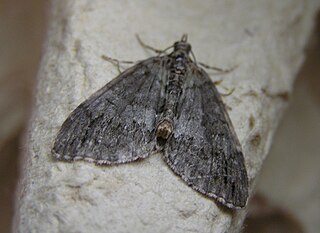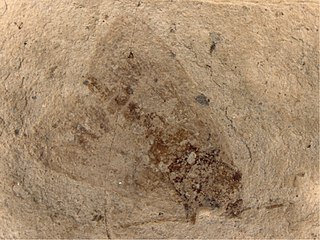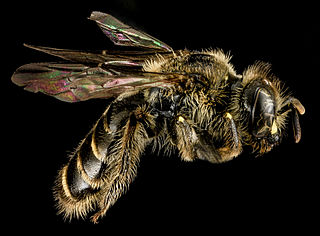Related Research Articles

Carpenter bees are species in the genus Xylocopa of the subfamily Xylocopinae. The genus includes some 500 bees in 31 subgenera. The common name "carpenter bee" derives from their nesting behavior; nearly all species burrow into hard plant material such as dead wood or bamboo. The main exceptions are species in the subgenus Proxylocopa, which dig nesting tunnels in suitable soil.

The geometer moths are moths belonging to the family Geometridae of the insect order Lepidoptera, the moths and butterflies. Their scientific name derives from the Ancient Greek geo γεω, and metron μέτρον "measure" in reference to the way their larvae, or inchworms, appear to measure the earth as they move along in a looping fashion. A very large family, it has around 23,000 species of moths described, and over 1400 species from six subfamilies indigenous to North America alone. A well-known member is the peppered moth, Biston betularia, which has been subject of numerous studies in population genetics. Several other geometer moths are notorious pests.

Alpheus Spring Packard Jr. LL.D. was an American entomologist and palaeontologist. He described over 500 new animal species – especially butterflies and moths – and was one of the founders of The American Naturalist.

Theodore Dru Alison Cockerell (1866–1948) was an entomologist and systematic biologist who published nearly 4,000 papers, some of them only a few lines long. Cockerell's speciality was the insect order Hymenoptera, an area of study where he described specimens from the United States, the West Indies, Honduras, the Philippines, Africa, and Asia. Cockerell named at least 5,500 species and varieties of bees and almost 150 genera and subgenera, representing over a quarter of all species of bees known during his lifetime. In addition to his extensive studies of bees, he published papers on scale insects, slugs, moths, fish scales, fungi, roses and other flowers, mollusks, and a wide variety of other plants and animals.
Lithodryas is a prehistoric genus of butterflies in the family Lycaenidae. It was introduced as a replacement for Samuel Hubbard Scudder's genus Lithopsyche, which is invalid as a homonym, as another fossil lepidopteran genus had been described under the same name shortly before Scudder established his genus.

Xerociris is a genus of moths in the family Noctuidae.It was erected by Theodore Dru Alison Cockerell in 1904. It is monotypic, being represented by the single species, Xerociris wilsonii, that was first described by Augustus Radcliffe Grote in 1863. It is found in the US state of Texas.
Eubarnesia is a monotypic moth genus in the family Geometridae erected by Theodore Dru Alison Cockerell in 1917. Its only species, Eubarnesia ritaria, described by Grossbeck in 1910, is found in the American South West.

Hydriomena is a genus of moths in the family Geometridae described by Jacob Hübner in 1825.

Sabulodes is a genus of moths in the family Geometridae first described by Achille Guenée in 1857.

Prehistoric Lepidoptera are both butterflies and moths that lived before recorded history. The fossil record for Lepidoptera is lacking in comparison to other winged species, and tending not to be as common as some other insects in the habitats that are most conducive to fossilization, such as lakes and ponds, and their juvenile stage has only the head capsule as a hard part that might be preserved. Yet there are fossils, some preserved in amber and some in very fine sediments. Leaf mines are also seen in fossil leaves, although the interpretation of them is tricky. Putative fossil stem group representatives of Amphiesmenoptera are known from the Triassic.

Paleolepidopterites is a collective genus of fossil moths which can not be placed in any defined family. The included species were formerly placed in the leaf-roller family Tortricidae and are known from fossils found in Russia and the United States. The collective genus contains three species: Paleolepidopterites destructus, Paleolepidopterites florissantanus, and Paleolepidopterites sadilenkoi, formerly placed within the genera Tortrix and Tortricites respectively. The three species were formally redescribed and moved to the new collective genus by Heikkilä et al. (2018).

Hydriomena? protrita is an extinct species of moth in the family Geometridae, and possibly in the modern genus Hydriomena. The species is known from late Eocene, Priabonian stage, lake deposits of the Florissant Formation in Teller County, Colorado, United States. It was first described by Theodore Dru Alison Cockerell in 1922.
Laetilia is a genus of snout moths. It was described by Émile Louis Ragonot in 1889.
Laetilia hulstii is a species of snout moth in the genus Laetilia. It was described by Theodore Dru Alison Cockerell in 1897. It is found in the US state of California.

Christabel Annie Cockerell, Lady Frampton was a British painter of children, portraits and landscapes.

Wilmatte Porter Cockerell was an American entomologist and high school biology teacher who discovered and collected a large number of insect specimens and other organisms. She participated in numerous research and collecting field trips including the Cockerell-Mackie-Ogilvie expedition. She wrote several scientific articles in her own right, co-authored more with her husband, Theodore Dru Alison Cockerell, and assisted him with his prolific scientific output. She discovered and cultivated red sunflowers, eventually selling the seeds to commercial seed companies. Her husband and her entomological colleagues named a number of taxa in her honor.

The Stenomatinae are a subfamily of small moths in the family Depressariidae.
Tetraopes submersus is an extinct species of beetle in the family Cerambycidae. It was described by Theodore Dru Alison Cockerell in 1908. It existed in what is now the United States.

Calliopsis is a genus of panurgine bees in the family Andrenidae. There are over 80 described species distributed throughout the western hemisphere.

Epeolus is a genus of cuckoo bees in the family Apidae. They are often known as variegated cuckoo-bees.
References
- ↑ "†Hexerites Cockerell 1933 (moth)". Fossilworks. Retrieved November 6, 2017.
- ↑ Savela, Markku. "Hexerites Cockerell, 1933". Lepidoptera and Some Other Life Forms. Retrieved November 6, 2017.